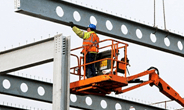Steel Markets

AGC and Two Chapters File Suit Against Vaccine Mandates
Written by David Schollaert
December 16, 2021
The Associated General Contractors of America (AGC) together with two of its chapters, the Dallas-based TEXO chapter and the statewide AGC of Texas chapter, filed suit earlier this week in federal court to block the Biden administration’s effort to impose a COVID-19 vaccine mandate on federal contractors and subcontractors.
According to the suit, the groups claim that many of their members who regularly construct federal projects are being harmed, as key workers seek jobs elsewhere in the industry to avoid the strict federal mandate.
“We are as eager as anyone to see more construction workers become fully vaccinated,” said Stephen Sandherr, AGC’s CEO. “But imposing a strict mandate on a small sector of the construction industry will only drive vaccine-hesitant workers out of that sector, and to one of the many other sectors also desperate for more workers.”
With nearly half of the construction workforce estimated to be vaccine-hesitant, and 89% of construction firms struggling to fill open positions, the new federal contractor mandate will encourage many workers to leave federal contractors for other companies, the association argued.
Instead of boosting vaccination rates within the workforce, the new mandate will leave federal construction projects struggling to reach completion on time and within budget. Nearly 15% of the federal contractors and subcontractors among the association’s members report they have already lost workers because of the new mandate.
AGC’s filing includes a motion for a temporary restraining order and statements from a number of contractors detailing the damages they have already begun to experience because of the new federal contractor vaccine mandate. That mandate is different from the broader vaccine mandate that OSHA has sought to impose on all firms that employ 100 or more people. That rule gives workers the option to be tested weekly, instead of being vaccinated. The AGC filed a legal challenge against that “emergency” OSHA standard in November.
“The federal contractor vaccine mandate is unlikely to increase vaccination rates among construction workers, but it will make it much harder for federal contractors to complete projects,” Sandherr noted. “Making federal construction slower, harder and more expensive won’t improve federal procurement or public health.”
While the AGC challenges the administration’s two coronavirus vaccine mandates, it continues to work to encourage all construction workers to get vaccinated, said Sandherr. The association recently released a series of public service ads featuring construction workers who nearly died from the virus urging their peers to get vaccinated. In addition to a vaccine toolkit for the industry, AGC has been advising its members to show the videos.

David Schollaert
Read more from David SchollaertLatest in Steel Markets

CMC looks beyond Arizona micro-mill woes to long-term viability of construction mart
Despite the economic and geopolitical upheaval of the last five years, CMC President and CEO Peter Matt points out that the construction market has been an essential element of the way forward.

US importers face stricter rules under revamped S232 tariffs
“CBP expects full compliance from the trade community for accurate reporting and payment of the additional duties. CBP will take enforcement action on non-compliance," the agency said in a March 7 bulletin.

Steel exports rebound in January
US steel exports recovered to a five-month high in January after having fallen to a two-year low in December. This growth follows four consecutive months of declining exports.

Construction spending drops marginally in January
Construction spending edged down slightly in January, slipping for the first time in four months. The US Census Bureau estimated spending at a seasonally adjusted annual rate of $2,196 billion in January, down 0.2% from December’s downward revised rate. The January figure is 3.3% higher than a year ago. January’s result, despite the slight erosion, […]

HVAC equipment shipments slow in December but strong annually
Shipments of heating and cooling equipment in the US fell to an 11-month low in December, according to the latest data released by the Air-Conditioning, Heating, and Refrigeration Institute (AHRI).
